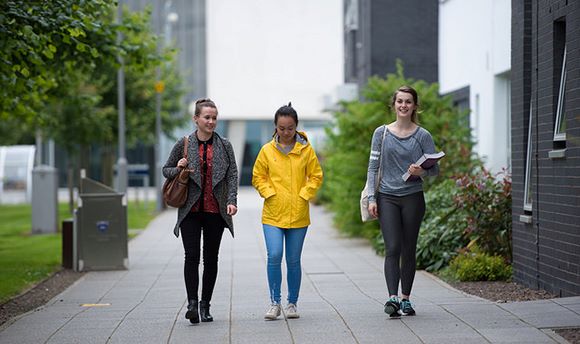QMU Strategic Report and Financial Statements 2022 - Strategic Report
Strategic Report
Status
Queen Margaret University, Edinburgh is an autonomous Scottish higher education institution. The University’s governing instruments and arrangements are set out under the Queen Margaret University, Edinburgh (Scotland) Order of Council 2007, amended from 1 October 2019 through the Queen Margaret University, Edinburgh (Scotland) Amendment Order of Council 2019. The 2007 Order is made under section 45 of the Further and Higher Education (Scotland) Act 1992. The University is registered under the Companies Acts as a company limited by guarantee, with its registered office at Queen Margaret University Drive, Musselburgh, East Lothian, EH21 6UU. The University has been entered into the Scottish Charity Register and is entitled, in accordance with section 13(1) of the Charities and Trustee Investment (Scotland) Act 2005, to refer to itself as a Charity registered in Scotland.
Scope of the financial statements
The financial statements presented on pages 20 to 43 comprise the consolidated results of the University and its subsidiary company, QMU Enterprises Limited. QMU Enterprises Limited undertakes commercial consultancy work, utilising the expertise of the University’s academic and technical staff, and also deals with vacation letting of the University’s student accommodation. The University holds 50% of the issued share capital of Edinburgh Innovation Park Joint Venture Company Limited. Due to the limited activity to date within the joint venture company, the results have not been consolidated into these financial statements. Further information is provided in note 13 to the financial statements.
The financial statements have been prepared on a going concern basis in accordance with Financial Reporting Standard 102 (FRS 102) and the Statement of Recommended Practice – Accounting for Further and Higher Education 2019 (SORP 2019), with the Accounts Direction issued by the Scottish Funding Council (SFC) and with the United Kingdom Companies Acts. Information on the process which has been undertaken to inform the decision to prepare the financial statements on a going concern basis is set out in section (A) in the statement of principal accounting policies.
Development of the strategic plan
The University’s strategic plan remains rooted in the University’s core values, and sets out a number of strategic goals, along with targets to be achieved by the end of the current plan period in 2025. The plan is supported by a more detailed delivery plan, which sets out specific actions, along with timescales and owners, which will enable the achievement of the strategic plan goals and targets. A key element of the plan remains the inclusion of key performance indicators which the University Court uses to monitor progress towards the achievement of the goals set out in the plan (both financial and non-financial). The University also has processes to manage the risks which might inhibit this achievement.
Results for the year
| Finance Income/Outcome |
2021/22 |
2020/21 |
|---|---|---|
| £Million | £Million | |
| Total Income | 48.3 | 44.0 |
| Total expenditure | (48.7) | (45.9) |
| (deficit) for the year | (0.4) | (1.9) |
|
Actuarial gain in respect of pension schemes |
24.1 | 12.7 |
|
Unrealised surplus /(deficit) on revaluation of land and buildings |
14.5 | (0.1) |
|
|
||
|
Total comprehensive income(expenditure)for the year |
38.2 |
10.7 |
The main changes in the underlying outturn position compared to 2020/21 were:-
- An increase of £2.0 million in income from tuition fees and education contracts, including additional students on new programmes, and an increase in international student numbers;
- An increase in SFC grants of £0.9 million. This included additional funding for the third year of the new initial teacher education programme and for the second year of the new paramedic science programme;
- A reduction of £200k in income from research grants and contracts;
- An increase in other income of £1.6 million, as summer school business returned close to pre-COVID levels;
- An increase of £2.2 million in staff costs, of which £1.5 million related to the movement in pension provision adjustments, with the remaining increase reflecting salary increases;
- An increase of £1.0 million in other operating expenses, largely relating to an increase in expenditure on long term maintenance following the hiatus in activity during the COVID pandemic.
Additional information on the adjustments relating to the revaluation of land and buildings and to actuarial gains and losses on pension schemes is provided in notes 12 and 21 respectively.
QMU Enterprises Ltd generated a profit of £157,000 (2020/21: £28,000), which was passed to the University under deed of covenant.
Cash flows and liquidity
The result for the year, adjusted for the effect of non-cash items and interest, was a net cash inflow of £7.9 million on operating activities (2020/21, £9.5 million inflow). Overall cash balances reduced by £0.4 million (2020/21; £6.8 million increase), after making an additional loan repayment of £5 million during the year. Unrestricted cash balances at 31 July 2022 of £15.2 million (2021: £15.3 million) represented 136 days’ expenditure (2021: 136 days).
Management of principal risks and uncertainties
In common with other universities, Queen Margaret University has to manage its activities whilst facing significant pressures on its funding as well as on its cost base. Significant risks facing the University include:-
- Funding from government through the Scottish Funding Council (SFC), the University’s main source of income, is likely to suffer from further real-terms reductions over the next few years as a consequence of spending cuts throughout the public sector.
- Recruitment of international and EU students continues to be challenging, largely as a result of difficulties faced by international students in obtaining visas to study in the UK, although this may be mitigated to some extent by the reinstatement of the post-study work visa.
- Pressure on staff costs will continue to build, both in terms of pay awards (where the University continues to participate in the UK-wide national negotiating framework) and also in terms of the cost of employers’ pension contributions.
- Inflationary pressures on other costs, particularly energy costs, will prove challenging in light of real terms reductions in funding.
- The ability to attract and retain staff, particularly in some specialist areas, is becoming more difficult throughout the economy, including in the University sector.
The identification and management of risks is firmly embedded within the University’s structure and processes. An updated risk management strategy was adopted by the University Court in 2021. The institutional corporate risk register, which includes a description of actions undertaken to mitigate risks, is formally reviewed by the Senior Leadership Team and the Audit & Risk Committee as well as being discussed by the University Court. The Court also undertakes, from time to time, an exercise to agree its appetite for risk, and to ensure that residual risks, after the application of mitigating actions, sit within the agreed tolerance.
Financial sustainability and going concern
The University Court has assessed the financial position of the University for the year ended 31 July 2022. The assessment period considered is the period to 31 July 2024 and further details of this assessment can be found on page 24. The University Court has assessed a number of factors as set out below and has concluded that there is an expectation that the University has adequate financial resources to continue to operate for the foreseeable future.
In reaching its conclusion, the University Court has considered the following factors:
- At the balance sheet date the University had net current assets of £7.6 million.
- Cash balances at 31 July 2022 amounted to £15.2 million. The University had liquid reserves (cash and investments) as at 31 July 2022 equivalent to approximately four and a half months’ operating cash requirements.
- In the year to 31 July 2022 the University made an underlying surplus of £3.2 million before pension provision adjustments, and generated positive net cash from operating activities of £7.9 million. The University cash flow forecast shows an increasing cash trajectory over the period to 31 July 2024, and no additional financing will be required to meet its liabilities.
- At the balance sheet date the University had external financing liabilities of £21.2 million, of which £18.5 million is payable to Barclays Bank plc with the remainder being payable to the Scottish Funding Council. As set out in Note 16, the University intends to enter into discussions around refinancing the element of the Barclays loan which will remain outstanding at the scheduled repayment date of 17 December 2024.
- All bank loan covenants were complied with for the year ended 31 July 2022.
- In relation to future years, we have considered headroom against covenants across a number of scenarios over the period to 31 July 2024. We consider that, on the basis of current forecasts, there is sufficient headroom on all bank covenants under each of the scenarios considered, on the basis that the University would take appropriate mitigating action. This would take the form of reducing discretionary expenditure by an amount which would allow all bank covenants to be met.
- Taking account of the business risks facing the University, we believe that the University and the group are well placed to continue to manage their business risks successfully.
In accordance with the recommendations from the Higher Education Financial Sustainability Strategy Group (FSSG), the University Court undertakes a formal annual assessment of the University’s financial sustainability. This process involves reviewing a common set of financial indicators, which have been applied to the University’s historical results and to the financial forecasts measured over a rolling five-year period, so as to reduce the impact of any one-off exceptional items arising in any year. The two key indicators which the University Court has agreed to focus upon to inform its considerations around financial sustainability are:-
- Earnings before interest, taxation, depreciation and amortisation (EBITDA); and
- Net cash flow from operating activities less interest payable as a percentage of turnover.
The second indicator has been adapted from the basket of financial indicators recommended by the FSSG as it is a more appropriate measure for the University, given its relatively high level of borrowings as a proportion of its turnover. The targets are also set at a level which will allow compliance with banking covenants. The results of the annual review undertaken in November 2022, based on a rolling five-year period, were as follows:-
| Indicator | Target | Average |
|---|---|---|
|
EBITDA |
12% | 13.3% |
|
Net cash flow from operating activities less interest payable as a percentage of turnover |
6% | 10.8% |
The EBITDA average percentage remains above the five-year average target, reflecting the positive result for 2021/22. The figure shows an increase from the July 2021 figure of 12.5%, reflecting the positive outturn for 2021/22. The “Net cash flow from operating activities less interest payable as a percentage of turnover”indicator remains well above target, reflecting the University’s relatively strong cash position.
Borrowings
Borrowings at 31 July 2022 amounted to £21.2 million (31 July 2021, £27.7 million). Of this amount, £18.5 million related to a secured loan facility with Barclays Bank plc taken out to fund the campus development at Musselburgh, and £2.7 million related to an unsecured loan from the Scottish Funding Council under the Financial Transactions scheme.
Pension arrangements
The University is involved in three pension schemes, as follows:-
The Lothian Pension Fund, which is part of the Local Government Pension Scheme (LGPS), is a multi-employer defined benefit scheme. The scheme’s last funding valuation took place as at 31 March 2020 and set contributions from 1 April 2021. The funding valuation showed a positive position with an overall funding position of 106%. The Fund trustees have, in recent years, applied increases to the level of employers’ and employees’ contributions to the scheme in order to maintain the strong funding position. The University’s share of the fund for 31 July 2022 is a net asset of £8.6 million (31 July 2021: £21.0 million liability). The University has not recognised the pension asset at 31 July 2022 in accordance with the accounting policy adopted as set out in accounting policy (D).
The most recent actuarial review of the Scottish Teachers’ Pension Scheme (STPS) was undertaken as at 31 March 2016. As a result of this review, the level of employers’ contribution to this scheme was increased from 17.2% to 23.0% with effect from 1 September 2019. The valuation identified a notional shortfall of £1.3 billion, which is being repaid by a supplementary rate of 4.3% of employers’ pension contributions over a 15-year period from 1 April 2019. This contribution is included in the 23.0% employers’ contribution rate.
The Universities Superannuation Scheme is a hybrid pension scheme, providing defined benefits (for all members), as well as defined contribution benefits. The assets of the scheme are held in a separate trustee-administered fund. Because of the mutual nature of the scheme, the assets are not attributed to individual institutions and a scheme-wide contribution rate is set. The University is therefore exposed to actuarial risks associated with other institutions’ employees and is unable to identify its share of the underlying assets and liabilities of the scheme on a consistent and reasonable basis. As required by Section 28 of FRS 102 (Employee Benefits), the University therefore accounts for the scheme as if it were a wholly defined contribution scheme. As a result, the amount charged to the consolidated Statement of Comprehensive Income and Expenditure represents the contributions payable to the scheme in respect of the accounting period. Since the University has entered into an agreement (the Recovery Plan) that determines how each employer within the scheme will fund the overall deficit, the University recognises a liability for the contributions payable that arise from the agreement (to the extent that they relate to the deficit) and therefore an expense is recognised in the income and expenditure account.
Further details on pension arrangements are set out in note 21 to the financial statements.
Social inclusion
Queen Margaret University aims to promote entry to, and provide education at, undergraduate and postgraduate level to a diverse range of students, whatever their background. In assessing candidates for admission to the University, we are committed to the principles of fairness, transparency, and widening participation. Our Contextual Admissions Policy commits to making offers to identified groups where we recognise that a range of factors may have impacted on attainment. We offer a range of recruitment, outreach, pre and post entry activities to raise aspiration, encourage access and maximise retention from under-represented groups in line with our Student Experience strategy, Mainstreaming Report and Equality Outcomes, and underpinned by the University’s Outcome Agreement with the Scottish Funding Council.
Student satisfaction
The University participates in the National Student Survey (NSS). The 2022 institutional results show an overall satisfaction score of 76.4%, Along with most other universities, this score has fallen, from 79.0% in 2021, as a result of the continuing disruption to the student experience caused by COVID-19. However, the score remains above the UK average score, and 4.1% above benchmark.
Graduate employment
Our Employability Strategy brings together in a single document our approach to employability, with the primary objective of providing equitable employment and careers education to all students and graduates, and providing a public statement of our commitment to their success. We consider that our efforts are proving highly effective. Graduate level employment is at a similar level to the previous year, although a change in the methodology used to calculate this measure at national level means that the precise figures are not directly comparable.
Environmental issues
The University has one of the “greenest” campuses in the UK, which received a BREEAM “excellent” rating. Sustainability remains at the heart of the University’s activities, which has been recognised through a number of green awards.
Future developments
In order to take advantage of further opportunities as they arise, the University is continuing to focus on ensuring that its academic, infrastructure, digital, human resources and financial strategies are closely aligned. Whilst operations have been affected by the COVID-19 pandemic over the last two years, the University continues to make good progress in a number of areas which will ensure that it is able to achieve the objectives set out in its strategic plan during the period through to 2025. This will, in turn, allow the University to continue to generate an adequate level of cash in the short to medium term and to maintain an adequate level of reserves. The Court carries out regular monitoring of the University’s financial sustainability, as described above.
The funding environment for Scottish higher education institutions was already challenging, with sector-level evidence that funding for publicly funded teaching and research was insufficient to cover the full cost of delivery. Whilst additional non-recurrent funding was made available to mitigate the financial losses arising from COVID, indications from the most recent Scottish Government spending review are that funding settlements for the next five years are likely to be at a flat-cash level, which represents a significant reduction in real terms. At the same time, universities will face significant pressures on costs, particularly staff costs and utilities costs. In order to address this position, the University has recently developed a five-year proposition, covering the period to 2027. This proposition involves targeting developments in three main areas, as follows:-
- Increasing postgraduate student numbers;
- Developing new online provision at scale; and
- Growth in transnational education partnerships.
The long term financial health of the University will continue to depend upon its ability to grow and diversify its income base, and to control costs, whilst making available sufficient funds needed as an upfront investment to enable the growth areas noted above to take place.
On behalf of the University Court
Pamela Woodburn
Chair



